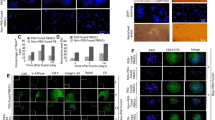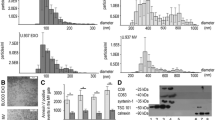Abstract
The bone remodeling process occurs through bone formation by osteoblasts and bone resorption by osteoclasts, a process involving the contribution of endocrine and nervous systems. The mechanisms associated to differentiation and proliferation of osteoclasts and osteoblasts are considered a potential therapeutic target for treating some erosive bone diseases. The aim of the present study is to explore the feasibility of generating active osteoclast-like cells from peripheral blood mononuclear cells (PBMCs) following polyethylene glycol (PEG)-induced fusion. PEG-fused PBMCs showed TRAP+-multinucleated cells and bone resorption activity, and were also positive for osteoclast markers such as carbonic anhydrase II, calcitonin receptor, vacuolar ATPase, and cathepsin K, when examined by reverse transcription-polymerase chain reaction, immunochemistry and Western blotting. TRAP expression and bone resorptive activity were higher in whole PEG-fused PBMCs than in separated T lymphocytes, B lymphocytes or monocytes. Both TRAP expression and bone resorptive activity were also higher in osteogenesis imperfecta patients compared to PEG-fused PBMCs from healthy individuals. PEG-induced fusion was more efficient in inducing TRAP and bone resorptive activities than macrophage colony-stimulating factor or dexamethasone treatment. Bone resorptive activity of PEG-fused PMBCs was inhibited by bisphosphonates. Evidence is provided that the use of PEG-based cell fusion is a straightforward and amenable method for studying human osteoclast differentiation and testing new therapeutic strategies.






Similar content being viewed by others
References
Choi Y, Arron JR, Townsend MJ (2009) Promising bone-related targets for rheumatoid arthritis therapy. Nat Rev Rheumatol 5:543–548
Lee NK (2010) Molecular understanding of osteoclast differentiation and physiology. Endocrinol Metab 25:264–269
Boyle WJ, Simonet WS, Lacey DL (2003) Osteoclast differentiation and activation. Nature 423:337–342
Chambers TJ (2000) Regulation of the differentiation and function of osteoclasts. J Pathol 192:4–13
Heinemann C, Heinemann S, Worch H, Hanke T (2011) Development of an osteoblast/osteoclast co-culture derived by human bone marrow stromal cells and human monocytes for biomaterials testing. Eur Cell Mater 21:80–93
Murillo A, Guerrero CA, Acosta O, Cardozo CA (2010) Bone resorptive activity of osteoclast-like cells generated in vitro by PEG-induced macrophage fusion. Biol Res 43:205–224
Rauch F, Glorieux F (2004) Osteogenesis imperfecta. Lancet 363:1377–1385
Cabral W, Chang W, Barnes A, Weis M, Scott M, Leikin S, Makareeva E, Kuznetsova NV, Rosenbaum KN, Tifft CJ, Bulas DI, Kozma C, Smith PA, Eyre DR, Marini JC (2007) Prolyl 3-hydroxylase 1 deficiency causes a recessive metabolic bone disorder resembling lethal/severe osteogenesis imperfect. Nat Genet 39:359–365
Davis MS, Kovacic BL, Marini JC, Shih AJ, Kozloff KM (2012) Increased susceptibility to microdamage in Brtl/+ mouse model for osteogenesis imperfecta. Bone 50:784–791
Collin-Osdoby P, Rothe L, Kwong M, Frigerio B, Morinishi L, Cabral WA, Osdoby P, Marini JC (2011) Osteoclast increases in the Brtl mouse model for osteogenesis imperfecta occur through marrow mesenchymal stromal cell dependent and independent mechanisms. Bone 48:S238
Li F, Wang X, Niyibizi C (2010) Bone marrow stromal cells contribute to bone formation following infusion into femoral cavities of a mouse model of osteogenesis imperfect. Bone 47:546–555
Campbell AM (1984) Monoclonal antibody technology. The production and characterization of rodent and human hybridomas. In: Burdon RH, van Knippenberg PH (eds) Laboratory techniques in biochemistry and molecular biology, vol 13. Elsevier, New York, pp 120–134
Coxon FP, Frith JC, Benford HL, Rogers MJ (2003) Isolation and purification of rabbit osteoclasts. In: Helfrich MH, Ralston SH (eds) Bone research protocols, methods in molecular medicine, vol 80. Humana Press Inc., Totowa, p 93
Reszka AA, Halasy-Nagy JM, Masarachia PJ, Rodan GA (1999) Bisphosphonates act directly on the osteoclast to induce caspase cleavage of mst1 kinase during apoptosis. A link between inhibition of the mevalonate pathway and regulation of an apoptosis promoting kinase. J Biol Chem 274:34967–34973
Brenner RE, Vetter U, Bollen A-M, Mörike M, Eyre DR (2009) Bone resorption assessed by immunoassay of urinary cross-linked collagen peptides in patients with osteogenesis imperfecta. J Bone Miner Res 9:993–997
Baron R, Gertner JM, Lang R, Vignery A (1983) Increased bone turnover with decreased bone formation by osteoblasts in children with osteogenesis imperfecta tarda. Pediatr Res 17:204–207
Susa M, Luong-Nguyen NH, Cappellen D, Zamurovic N, Gamse R (2004) Human primary osteoclasts: in vitro generation and applications as pharmacological and clinical assay. J Transl Med 2:6. doi:10.1186/1479-5876-2-6
Kim YH, Jun JH, Woo KM, Ryoo HM, Kim GS, Baek JH (2006) Dexamethasone inhibits the formation of multinucleated osteoclasts via down-regulation of beta3 integrin expression. Arch Pharm Res 29:691–698
Xing L, Xiu Y, Boyce BF (2012) Osteoclast fusion and regulation by RANKL-dependent and independent factors. World J Orthop 3:212–222
Yagi M, Miyamoto T, Sawatani Y, Iwamoto K, Hosogane N, Fujita N, Morita K, Ninomiya K, Suzuki T, Miyamoto K, Oike Y, Takeya M, Toyama Y, Suda T (2005) DC-STAMP is essential for cell-cell fusion in osteoclasts and foreign body giant cells. J Exp Med 202:345–351
Verrier S, Hogan A, McKie N, Horton M (2004) ADAM gene expression and regulation during human osteoclast formation. Bone 35:34–46
Kalajzic I, Terzic J, Rumboldt Z, Mack K, Naprta A, Ledgard F, Gronowicz G, Clark SH, Rowe DW (2002) Osteoblastic response to the defective matrix in the osteogenesis imperfecta murine (oim) mouse. Endocrinology 143:1594–1601
Author information
Authors and Affiliations
Corresponding author
Ethics declarations
Conflict of interest
Edwin Manrique, Luz M. Castillo, Oswaldo Lazala, Carlos A. Guerrero, Orlando Acosta declare that they have no conflict of interest.
About this article
Cite this article
Manrique, E., Castillo, L.M., Lazala, O. et al. Bone resorptive activity of human peripheral blood mononuclear cells after fusion with polyethylene glycol. J Bone Miner Metab 35, 127–141 (2017). https://doi.org/10.1007/s00774-016-0744-0
Received:
Accepted:
Published:
Issue Date:
DOI: https://doi.org/10.1007/s00774-016-0744-0




